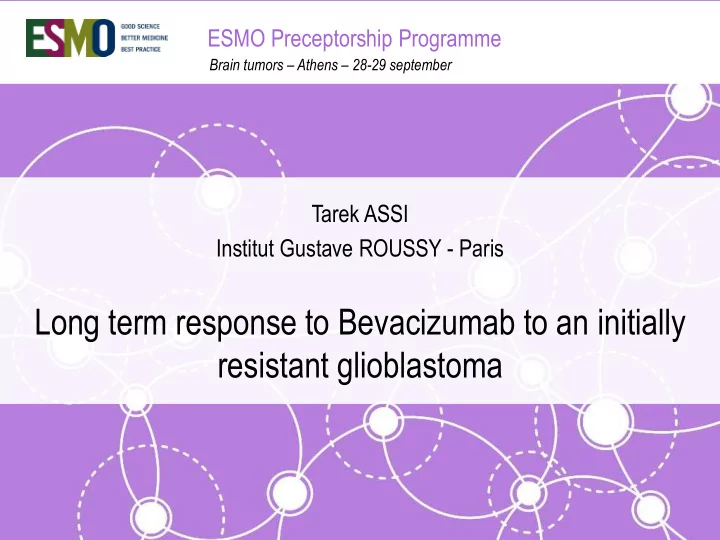

ESMO Preceptorship Programme Brain tumors – Athens – 28-29 september Tarek ASSI Institut Gustave ROUSSY - Paris Long term response to Bevacizumab to an initially resistant glioblastoma
No conflict of interests ESMO PRECEPTORSHIP PROGRAMME
Initial Presentation Age : 38 years. History of diabetes and HTA. December 2011: Generalized seizure. Diagnosis of a parasagittal precentral frontal glioblastoma. Surgery performed with complete resection of the brain tumor. ESMO PRECEPTORSHIP PROGRAMME
Adjuvant Therapy January 2012: – STUPP protocol: • Radiotherapy of 60 Gy in 30 sessions • Temozolomide 150 mg per day during radiotherapy. • Received two cycles of Temozolomide 200 mg/m2 = 400 mg for 5 days every 4 weeks – After the second cycle = A new generalized seizure. ESMO PRECEPTORSHIP PROGRAMME
First relapse therapy MRI of the brain performed: – Multinodular increased contrast enhancement in the frontal lobe region. Decision to start Lomustine – Due to logistic issues: Procarbazine 60mg/m2 for 2 weeks every 4 weeks. • September 2012 (After 3 months), • Aphasia and somnolence • MRI : increased contrast enhancement with local frontal lobe progression. ESMO PRECEPTORSHIP PROGRAMME
Second relapse therapy Avastin 10mg/kg every 2 weeks at the dose of 770mg started on August 2012. – Initial decreased contrast enhancement with persistent response. After 4 cycles – After two years, increased proteinuria with decision to maintain Avastin at the dose of 15 mg/kg every 3 weeks – Persistent response for 3 years until September 2015 ESMO PRECEPTORSHIP PROGRAMME
Therapeutic Holiday September 2015 : Decision to start therapeutic holiday with surveillance and MRI every 3 months. September 2016 :Maintained stable disease MRI every 6 months. September 2017 : memory trouble MRI demonstrated increased contrast enhancement in the frontal lesion. ESMO PRECEPTORSHIP PROGRAMME
Third Relapse October 2017: status epilepticus – MRI : • an increased leptomeningeal contrast enhancement as well as in the superior region of the frontal lobe. – Surgery was revoked due to the multifocality of the lesions. – Admission to the critical care facility. – Right hemiplegia with conscience problems. – Improved conscience with adjustment of antiepileptic drugs. Rechallenge with Bevacizumab 15mg/kg every 3 weeks – After two cycles in January 2018 : Persistent hemiplegia but improved clinical status with decreased contrast enhancement on MRI. ESMO PRECEPTORSHIP PROGRAMME
ESMO Preceptorship Programme
Recommend
More recommend